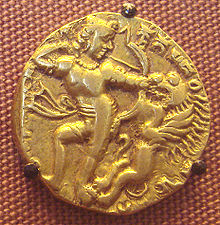Kumaragupta
| Kumaragupta I | |
|---|---|

Gold coin of Kumaragupta.
|
|
| 7th Gupta Emperor | |
| Reign | c. 414 – c. 455 CE |
| Predecessor | Chandragupta II |
| Successor | Skandagupta |
| Issue |
Skandagupta Purugupta |
| Dynasty | Gupta |
| Father | Chandragupta II |
| Mother | Dhruvadevi |
Kumaragupta I, also known as Shakraditya and Mahendraditya, was an emperor of the Gupta Empire in 415–455 CE. He was the son of his predecessor, Chandragupta II, and Dhruvadevi (also known as Dhruvasvamini). He was an able ruler and retained, intact, the vast empire, which extended from Bengal to Kathiawar and from the Himalayas to the Narmada. He ruled efficiently for nearly forty years. However, the last days of his reign were not good. The Gupta Empire was threatened by the rebellion of Pushyamitras of central India and invasion of the White Huns. But, Kumaragupta was successful in defeating both threats and performed the Ashvamedha (horse sacrifice) to celebrate his victory. He issued new coins with images of his namesake, Lord Kumara.
During his reign, Chiratadatta was the governor of Pundravardhana Bhukti. A prince, Ghatotkachagupta was the governor of Eran and a third governor (or feudatory), Bandhuvarma was the ruler of Dashapura. The Karmadande inscription (436 CE) mentions Prithivishena, who was initially mantrin and kumaramatya (minister) of Kumaragupta I, but later became his mahabaladhikrita (general).
Modern scholars are divided in opinion regarding the immediate successor of Kumaragupta I. While some believe that he was succeeded by his son Skandagupta, others contend that he was succeeded by his other son, Purugupta. Some even think that Skandagupta and Purugupta are the same person.
The Junagadh rock inscription of Skandagupta mentions:
…whom the goddess of fortune and splendour of her own accord selected as her husband, having in succession (and) with judgment skillfully taken into consideration and thought over all the causes of virtues and faults, (and) having discarded all (the other) sons of kings (as not coming up to her standard).
The full significance of this passage is obscure. It is, however, certain that the superior ability and prowess of Skandagupta in a time of crisis led to his choice as ruler in preference to other possible claimants after the death of Kumaragupta I and proud of his successes against the barbarians, Skandagupta assumed the title of Vikramaditya.
...
Wikipedia
